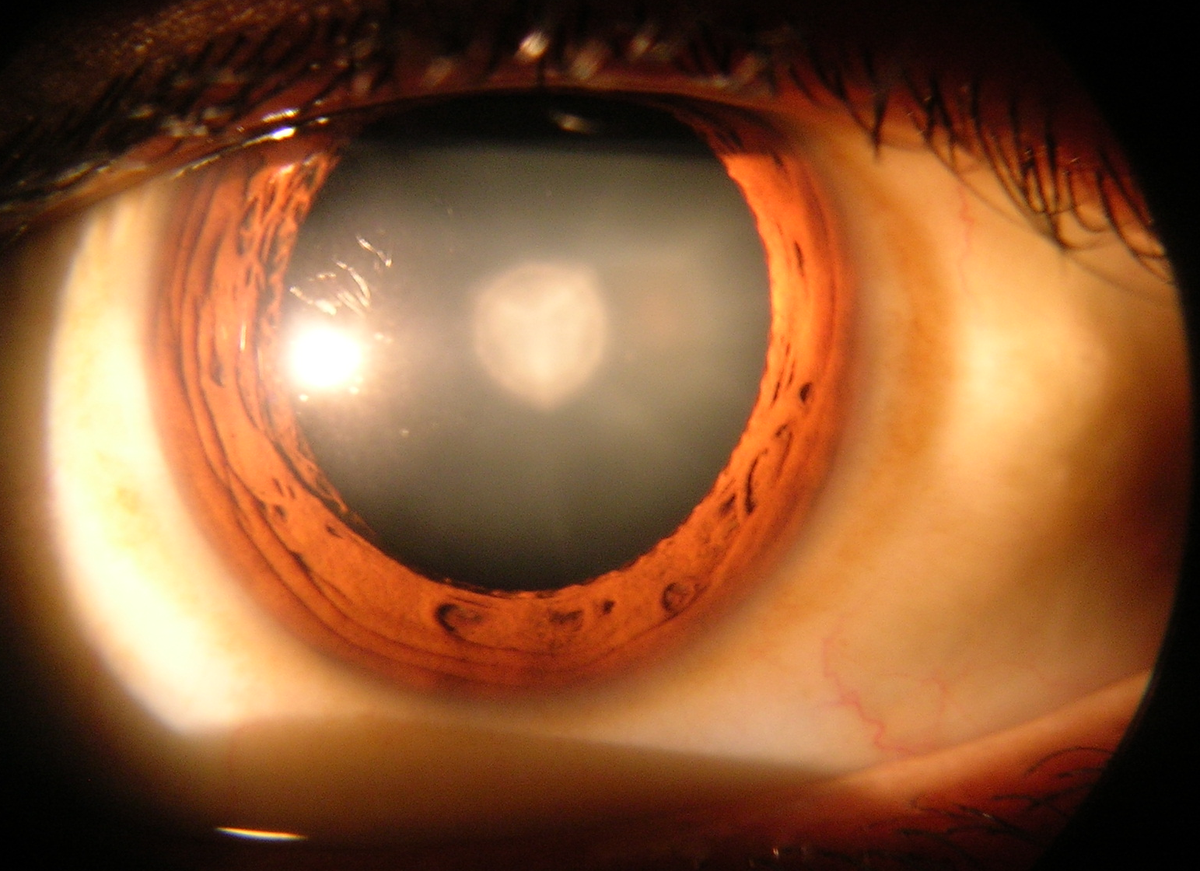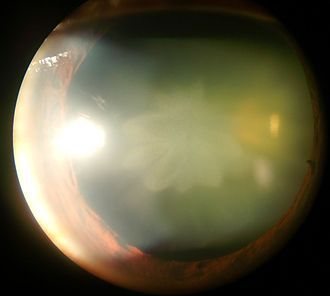Cataract
Kontributor Utama : Dr. Sharita R. Siregar, SpM(K), DR. Dr. Johan A. Hutauruk, SpM(K)
Untuk melihat artikel ini dalam kondisi terupdate, silakan menuju halaman ini.
| Cataract | |
|---|---|

|
|
|
Faded colors, blurry vision, halos around light, trouble with bright lights, trouble seeing at night |
|
|
Usual onset |
Gradual |
|
Causes |
Aging, trauma, radiation exposure, following eye surgery, genetic |
A cataract is a cloudy area in the lens of the eye that leads to a decrease in vision.[1][2] Cataracts often develop slowly and can affect one or both eyes.[1] Symptoms may include faded colors, blurry or double vision, halos around light, trouble with bright lights, and trouble seeing at night.[1] This may result in trouble driving, reading, or recognizing faces.[3] Poor vision caused by cataracts may also result in an increased risk of falling and depression.[4] Cataracts cause half of all cases of blindness and 33% of visual impairment worldwide.[5][6]
Cataracts are most commonly due to aging but may also occur due to trauma or radiation exposure, be present from birth, or occur following eye surgery for other problems.[1][7] Risk factors include diabetes, longstanding use of corticosteroid medication, smoking tobacco, prolonged exposure to sunlight, and alcohol.[1] The underlying mechanism involves accumulation of clumps of protein or yellow-brown pigment in the lens that reduces transmission of light to the retina at the back of the eye.[1] Diagnosis is by an eye examination.[1]
Prevention includes wearing sunglasses and a wide brimmed hat, eating leafy vegetables and fruits, and avoiding smoking.[1][8] Early on the symptoms may be improved with glasses.[1] If this does not help, surgery to remove the cloudy lens and replace it with an artificial lens is the only effective treatment.[1] Cataract surgery is not readily available in many countries, and surgery is needed only if the cataracts are causing problems and generally results in an improved quality of life.[1][9][7][10]
About 20 million people worldwide are blind due to cataracts.[7] It is the cause of approximately 5% of blindness in the United States and nearly 60% of blindness in parts of Africa and South America.[10] Blindness from cataracts occurs in about 10 to 40 per 100,000 children in the developing world, and 1 to 4 per 100,000 children in the developed world.[2] Cataracts become more common with age.[1] In the United States, cataracts occur in 68% of those over the age of 80 years.[11] Additionally they are more common in women, and less common in Hispanic and Black people.[11]
Signs and symptoms
Sign and symptom.[12]
The severity of cataract formation, assuming no other eye disease is present, is judged primarily by a visual acuity test. Other symptoms include frequent changes of glasses and colored halos due to hydration of lens.[15]
Congenital cataracts[14] can result in amblyopia if not treated in a timely manner.[13]
Causes
_PHIL_4284_lores.jpg)
|
|
Bilateral cataracts in an infant due to congenital rubella syndrome |

|
Age
Age is the most common cause of cataracts.[1][4] Lens proteins denature and degrade over time, and this process is accelerated by diseases such as diabetes mellitus and hypertension. Environmental factors, including toxins, radiation, and ultraviolet light have cumulative effects which are worsened by the loss of protective and restorative mechanisms due to alterations in gene expression and chemical processes within the eye.[16]
Oxidative stress is an important pathogenic mechanism in cataract formation (see[17] for review). Senile cataracts are associated with a decrease in antioxidant capacity in the lens.[17] An increase in oxidative stress in the lens or a decrease in the ability to remove reactive oxygen species can lead to the lens becoming more opaque.
Trauma
Post traumatic rosette cataract of a 60-year-old male
Blunt trauma causes swelling, thickening, and whitening of the lens fibers. While the swelling normally resolves with time, the white color may remain. In severe blunt trauma, or in injuries that penetrate the eye, the capsule in which the lens sits can be damaged. This damage allows fluid from other parts of the eye to rapidly enter the lens leading to swelling and then whitening, obstructing light from reaching the retina at the back of the eye. Cataracts may develop in 0.7 to 8.0% of cases following electrical injuries.[18] Blunt trauma can also result in star- (stellate) or petal-shaped cataracts.[19]
Radiation
Cataracts can arise as an effect of exposure to various types of radiation. X-rays, one form of ionizing radiation, may damage the DNA of lens cells.[20] Ultraviolet light, specifically UVB, has also been shown to cause cataracts, and some evidence indicates sunglasses worn at an early age can slow its development in later life.[21] Microwaves, a type of nonionizing radiation, may cause harm by denaturing protective enzymes (e.g., glutathione peroxidase), by oxidizing protein thiol groups (causing protein aggregation), or by damaging lens cells via thermoelastic expansion.[20] The protein coagulation caused by electric and heat injuries whitens the lens.[16] This same process is what makes the clear albumen of an egg become white and opaque during cooking.[citation needed]
Genetics
Christmas tree cataract (diffuse illumination)
The genetic component is strong in the development of cataracts,[22] most commonly through mechanisms that protect and maintain the lens. The presence of cataracts in childhood or early life can occasionally be due to a particular syndrome. Examples of chromosome abnormalities associated with cataracts include 1q21.1 deletion syndrome, cri-du-chat syndrome, Down syndrome, Patau's syndrome, trisomy 18 (Edward's syndrome), and Turner's syndrome, and in the case of neurofibromatosis type 2, juvenile cataract on one or both sides may be noted. Examples of single-gene disorder include Alport's syndrome, Conradi's syndrome, cerebrotendineous xanthomatosis, myotonic dystrophy, and oculocerebrorenal syndrome or Lowe syndrome.[citation needed]
Skin diseases
The skin and the lens have the same embryological origin and so can be affected by similar diseases.[23] Those with atopic dermatitis and eczema occasionally develop shield ulcer cataracts. Ichthyosis is an autosomal recessive disorder associated with cuneiform cataracts and nuclear sclerosis. Basal-cell nevus and pemphigus have similar associations.
Smoking and alcohol
Cigarette smoking has been shown to double the rate of nuclear sclerotic cataracts and triple the rate of posterior subcapsular cataracts.[24] Evidence is conflicting over the effect of alcohol. Some surveys have shown a link, but others which followed people over longer terms have not.[25]
Inadequate vitamin C
Low vitamin C intake and serum levels have been associated with greater cataract rates.[26] However, use of supplements of vitamin C has not demonstrated benefit.[27]
Medications
Some medications, such as systemic, topical, or inhaled corticosteroids, may increase the risk of cataract development.[28][29] Corticosteroids most commonly cause posterior subcapsular cataracts.[29] People with schizophrenia often have risk factors for lens opacities (such as diabetes, hypertension, and poor nutrition) but antipsychotic medications are unlikely to contribute to cataract formation.[30] Miotics[31] and triparanol may increase the risk.[32]
Post-operative
Nearly every person who undergoes a vitrectomy—without ever having had cataract surgery—will experience progression of nuclear sclerosis after the operation.[33] This may be because the native vitreous humor is different from the solutions used to replace the vitreous (vitreous substitutes), such as BSS Plus.[34] This may also be because the native vitreous humour contains ascorbic acid which helps neutralize oxidative damage to the lens and because conventional vitreous substitutes do not contain ascorbic acid.[35][36] Accordingly, for phakic patients requiring a vitrectomy it is becoming increasingly common for ophthalmologists to offer the vitrectomy combined with prophylactic cataract surgery to prevent cataract formation.
Other diseases
- Metabolic and nutritional diseases
- Aminoaciduria or Lowe's syndrome
- Cerebrotendineous xanthomatosis
- Diabetes mellitus
- Fabry's disease
- Galactosemia / galactosemic cataract
- Homocystinuria
- Hyperparathyroidism
- Hypoparathyroidism
- Hypervitaminosis D
- Hypothyroidism
- Hypocalcaemia
- Mucopolysaccharidoses
- Wilson's disease
- Congenital
- Congenital syphilis
- Cytomegalic inclusion disease
- Rubella
- Cockayne syndrome
- Genetic syndromes
- Down syndrome
- Patau syndrome
- Edwards syndrome
- Infections:
- Cysticercosis
- Leprosy
- Onchocerciasis
- Toxoplasmosis
- Varicella
- Secondary to other eye diseases:
- Retinopathy of prematurity
- Aniridia
- Uveitis
- Retinal detachment
- Retinitis pigmentosa
References
- "Facts About Cataract". September 2009. Archived from the original on 24 May 2015. Retrieved 24 May 2015.
- Pandey SK (2005). Pediatric cataract surgery techniques, complications, and management. Philadelphia: Lippincott Williams & Wilkins. p. 20. ISBN 978-0781743075. Archived from the original on 2015-05-24.
- Allen D, Vasavada A (July 2006). "Cataract and surgery for cataract". BMJ. 333 (7559): 128–132. doi:10.1136/bmj.333.7559.128. PMC 1502210. PMID 16840470.
- Gimbel HV, Dardzhikova AA (January 2011). "Consequences of waiting for cataract surgery". Current Opinion in Ophthalmology. 22 (1): 28–30. doi:10.1097/icu.0b013e328341425d. PMID 21076306. S2CID 205670956.
- "Visual impairment and blindness Fact Sheet N°282". August 2014. Archived from the original on 12 May 2015. Retrieved 23 May 201
- Global Data on Visual Impairments 2010 (PDF). WHO. 2012. p. 6. Archived (PDF) from the original on 2015-03-31.
- "Priority eye diseases". Archived from the original on 24 May 2015. Retrieved 24 May 2015.
- "Recognizing Cataracts". NIH News in Health. 2017-05-30. Retrieved 2020-02-02. Try wearing sunglasses or a hat with a brim. Researchers also believe that good nutrition can help reduce the risk of age-related cataract. They recommend eating plenty of green leafy vegetables, fruits, nuts and other healthy foods.
- Lamoureux EL, Fenwick E, Pesudovs K, Tan D (January 2011). "The impact of cataract surgery on quality of life". Current Opinion in Ophthalmology. 22 (1): 19–27. doi:10.1097/icu.0b013e3283414284. PMID 21088580. S2CID 22760161.
- Rao GN, Khanna R, Payal A (January 2011). "The global burden of cataract". Current Opinion in Ophthalmology. 22 (1): 4–9. doi:10.1097/icu.0b013e3283414fc8. PMID 21107260. S2CID 205670997.
- "Cataract Data and Statistics | National Eye Institute". www.nei.nih.gov. Retrieved 2019-11-18.
- "Posterior Supcapsular Cataract". Digital Reference of Ophthalmology. Edward S. Harkness Eye Institute, Department of Ophthalmology of Columbia University. 2003. Archived from the original on 27 March 2013. Retrieved 2 April 2013.
- Mohammadpour M, Shaabani A, Sahraian A, Momenaei B, Tayebi F, Bayat R, Mirshahi R (June 2019). "Updates on managements of pediatric cataract". Journal of Current Ophthalmology. 31 (2): 118–126. doi:10.1016/j.joco.2018.11.005. PMC 6611931. PMID 31317088.
Tag: vision cataract mata blindness ophthalmology

